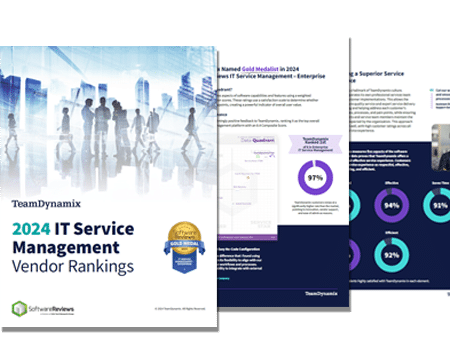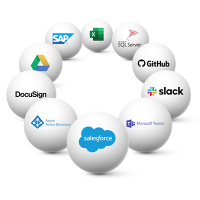
Companies Say They Need Automation, Easy-to-Manage ITSM
A study from Information Week and TeamDynamix shows companies are looking to invest in IT Service Management (ITSM) software that is simple to administer and

The Info-Tech ranking report offers a unique view of the market based entirely on in-depth customer interviews. Download the Info-Tech ITSM Quadrant and Customer Viewpoint report today.

We’ll show you some of our best situations and show you exactly how to execute them to get immediate results. The best part is, iPaaS tools often feature easy-to-use click and drag functionality, meaning you don’t need a dedicated employee building integrations and workflows.

System Integrators, Value Added Resellers, Technology Providers, and Buying Consortiums can benefit from a partnership with TeamDynamix.

The Info-Tech ranking report offers a unique view of the market based entirely on in-depth customer interviews. Download the Info-Tech ITSM Quadrant and Customer Viewpoint report to gain a better understanding of key vendor strengths and emerging market requirements.
 There is a wave of tech spend that’s been growing at the state and local level, and thanks to the proliferation of digital transformation and smart cities initiatives, there’s no sign of it slowing down.
There is a wave of tech spend that’s been growing at the state and local level, and thanks to the proliferation of digital transformation and smart cities initiatives, there’s no sign of it slowing down.
Consider the following:
This increase in tech spend translates to an increase in tech projects and an increase in the number of products or services that need to be supported. How can IT leaders make the most of the resources they currently have at their disposal?
Trend 1: Manage Support Tickets and Projects Together
Optimizing resources means that we need to think strategically about how we allocate and manage time. For instance, if you have resources working on support tickets using a standalone ITSM platform and then you have a separate tracking system for projects, you are apt to underutilize resources or miss deadlines. In short, adopting a platform that brings IT service and project management together will help IT leaders get a better handle on who is doing what and who can be assigned to new work coming in.
Trend 2: Leverage a Self-Service Portal
It is estimated that a typical tier 1 support request via phone, email, or walk-in costs $22, whereas self-service is just $2 per incident3. A comprehensive, searchable knowledge base coupled with an accessible portal will reduce the drain on your support desk, allowing technicians to focus on strategic projects, proper change management, and improved overall tech experience.
Trend 3: Project Management – One Size Does NOT Fit All
As projects will come in all shapes and sizes, it is important that we use a framework that suits the job. For instance, using a Waterfall approach for a basic team collaboration project will exhaust the team and result in poor outcomes. Therefore, it is critical to have the flexibility to use Waterfall, Agile, KANBAN, or basic team collaboration as the project warrants. The other key factor is to adopt a portfolio approach. This way you can see all projects and resources in one view.
Be prepared: bring service & project management together on a single platform. Learn more
1whitehouse.gov
2IDC 2019 Figures
3HDI

A study from Information Week and TeamDynamix shows companies are looking to invest in IT Service Management (ITSM) software that is simple to administer and

When it comes to improving IT Service Management (ITSM) maturity, many organizations turn to ITIL – a framework that guides users through a process-based approach

Enterprise Service Management (ESM) is the practice of extending IT Service Management (ITSM) principles beyond the IT department to other areas of an organization. ESM
TeamDynamix’s award-winning SaaS cloud solution offers IT Service and Project Management together on one platform with enterprise integration and automation.
[email protected]
(877) 752-6196
Contact Us
